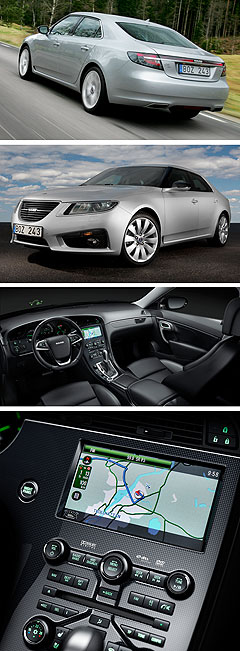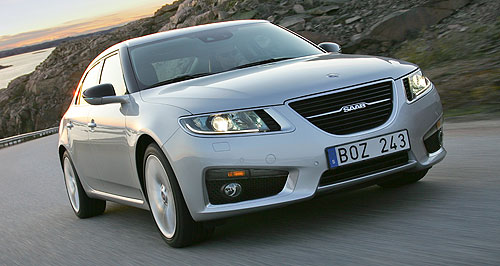Future models - Saab - 9-5Saab’s 9-5 grows upHow Swede it is: Saab's new 9-5 might be on sale in Australia by the end of the year. Spacious Saab flagship comes out swinging for Saab’s survival after cheating death2 Jun 2010 SAAB’S first new model since its separation from General Motors – the second-generation, bigger 9-5 luxury flagship – has been unveiled in Sweden ahead of a 23-nation roll-out that might include Australia before the end of the year. Boasting an all-turbo powertrain line-up in six petrol, diesel and E85 ethanol alternatives in four-cylinder and Holden-made V6, the spacious and smooth new 9-5 has already won positive reviews from key motoring journalists, much to the relief of Saab and new owner Spyker NV which both need the new flagship to drive their venture back to profitability by 2012 if the organisation is to survive. Spyker also announced it had bought Saab’s UK distributorship, Saab Great Britain, from General Motors UK, thereby securing the Saab brand in the company’s third biggest market. While nothing official has been announced about the future of Saab distribution in Australia, Reuters reports that Australia is one of seven other overseas markets where the marque’s distribution operations will be separated from GM and re-launched by the end of the year. Saab’s global sales director, Adrian Hallmark, told Reuters that the company hoped to complete the process of buying out distributorships and building new operations in 23 countries by September. He said Saab was positioning itself to sell cars directly to dealerships instead of through an intermediary, which should help the profit margin on each car.  Holden’s GM Premium Brands, which has continued to keep the Saab business ticking over with parts supply and other obligations, confirmed to GoAuto that it was still planning to unload the Saab business in Australia once other arrangements had been made. Holden’s GM Premium Brands, which has continued to keep the Saab business ticking over with parts supply and other obligations, confirmed to GoAuto that it was still planning to unload the Saab business in Australia once other arrangements had been made.But Holden corporate communications manager Emma Watts told GoAuto that GM Holden would continue to work with Saab customers until alternative arrangements had been made. "We are fully committed to working with Saab customers during this transition," she said. So far, no independent distributor has put up their hand for the business, publicly at least, and Saab dealers have told GoAuto the sales network is still hanging, awaiting a decision. “All we need is cars,” said one frustrated dealer who requested to remain anonymous. If Spyker – maker of niche sports cars in Holland – does set up its own in organisation in Australia, it is possible it might sub-contract the parts business to Holden, which GoAuto understands is keen to retain that business. Holden spokesperson Emily Perry said that until the future of Saab was decided in Australia, Holden might facilitate wholesale car purchases for any Saab dealer that wanted to set up their own purchase arrangements with the Saab factory in Sweden. However, a dealer told GoAuto that while he wanted to resume Saab sales as soon as possible, he would not consider importing any vehicles until he knew whether his franchise would be retained by whomever would take over the distributorship. “I have a franchise agreement, but I guess that will be torn up when the distribution changes hands,” he said. “Until I know that I have a future with Saab, we can’t really do anything.” GM retained a $363 million slice of Saab when it sold the business to Spyker in January, so it has a vested interest in ensuring the brand survives. Saab was only days from closing its doors when GM reached an agreement with Spyker CEO and major shareholder Victor Muller to sell the Swedish brand and its facilities at Trollhattan to the Dutch company after it secured a €400 million ($A587m) loan from the European Investment Bank, backed by a Swedish government guarantee. Had Saab died, it would have taken the stillborn 9-5 with it, even though it was ready to roll down the production line. Designed and engineered over five years by Saab under the former GM regime, the new 9-5 shares its platform with Opel/Vauxhall’s Insignia, although Saab modifications include more sophisticated suspension and an extra 10cm in the wheelbase to expand cabin space to large-car levels. The Saab 9-5 will debut with 2.0-litre diesel and petrol four-cylinder engines developing 118kW/350Nm and 162kW/350Nm respectively, along with the Australian-built turbocharged 221kW/400Nm 2.8-litre V6. Related to the Holden Commodore’s 3.0-litre and 3.6-litre V6s, the twin-scroll turbo V6 also powers the Saab 9-3 Aero, but reportedly has been upgraded for quieter, smoother operation in the 9-5. Saab quotes a 0-100km/h sprint time of 6.9 seconds for the 2.8T. Later this year, the engine range will be expanded with a fuel-sipping low-pressure-turbo 132kW/230Nm 1.6-litre four cylinder, an ethanol-capable version of the 2.0-litre four-cylinder with performance matching the petrol variant, and a high-performance two-stage turbo diesel generating 140kW/400Nm. The latter – dubbed 2.0 TTiD – will be sold in front-wheel drive with the same sports suspension settings as the 2.8T. Best fuel economy is 5.3 litres per 100km for the 2.0TiD diesel (CO2 139g/km), while the 1.6 Turbo engine is expected to return 7.6L/100km. All manual and automatic transmissions are six-speed, while the high-performance V6 flagship will be available only with Saab’s proprietary XWD all-wheel-drive system – a carryover from the 9-3 – which will also be available with all other variants except the 1.6-litre entry level powertrain. The Saab-designed body – inspired by the Aero X concept car – has a traditional three-box look, avoiding what Saab calls the “coupe cliché” prevalent in modern European luxury car design. Saab says it targeted the Audi A6 when setting its performance and comfort goals for the new 9-5, and it started by expanding the body to more than five metres in length, rivaling the BMW 7 Series. This also helps to set it apart from the entry-level 9-3. The big Saab rides on active ‘Skyhook’ suspension, which affords a superior ride, according to early reports from the media launch in Sweden where more than 200 journalists gathered at the company’s Trollhattan headquarters and factory. Unlike the tight confines of the Saab 9-3, the 9-5 gets expansive cabin space, with plenty of legroom front and rear. Along with keyless entry, the cabin gains an optional head-up display and start/stop button which – in Saab tradition – remains between the front seats, next to the gear shift. Infotainment choices include a top-of-the-line Harman/Kardon surround-sound audio system and an eight-inch touchscreen navigation system with hard disk storage for map data and 10 GB of jukebox-style music files. Spkyer CEO Victor Muller said the Saab 9-5 was vital to Saab’s future. “Every day we get stronger, every day we get more orders from dealers,” he said. “We expect to be profitable in two years, after a full year of 9-5, a full year of Combi and a full year of 9-4X.” Along with the forthcoming Saab 9-4X SUV – a variant of the Mexican-made Cadillac SRX – the 9-5 holds the key to the company’s aspirations to build at least 100,000 cars a year, at which it should become profitable.  Read more7th of April 2010  Saab to recycle 9-3Current Saab 9-3 platform will be re-employed beneath a new model in 201226th of March 2010  Saab 9-5 still on iceBuyers can order new 9-5 in Europe, but Saab remains in limbo Down Under24th of March 2010  Saab goes back to workFirst cars manufactured by Saab as an independent company one month after GM sale28th of January 2010  Saab saviour thanks 'Tassie Devil'How a Hobart website helped to mobilise the ‘Save Saab’ global campaign27th of January 2010  GM offloads SaabSaab finally sold to Spyker but GM retains part ownership |
Click to shareSaab modelsResearch Saab Motor industry news |














Facebook Twitter Instagram